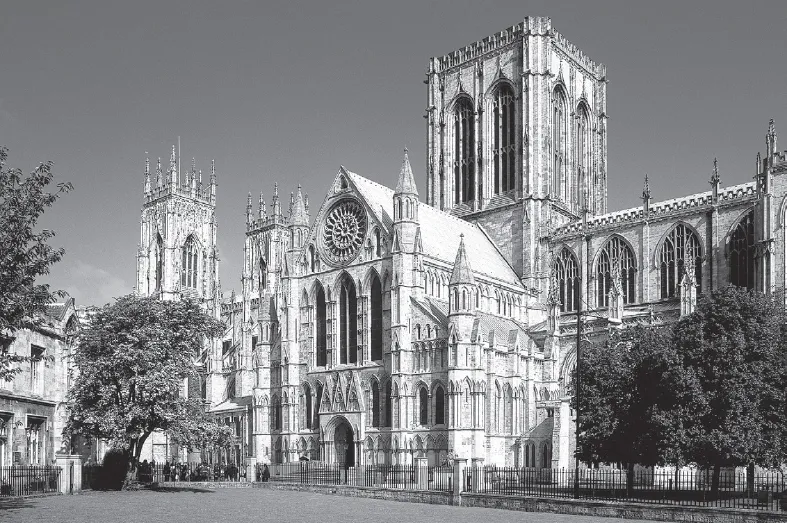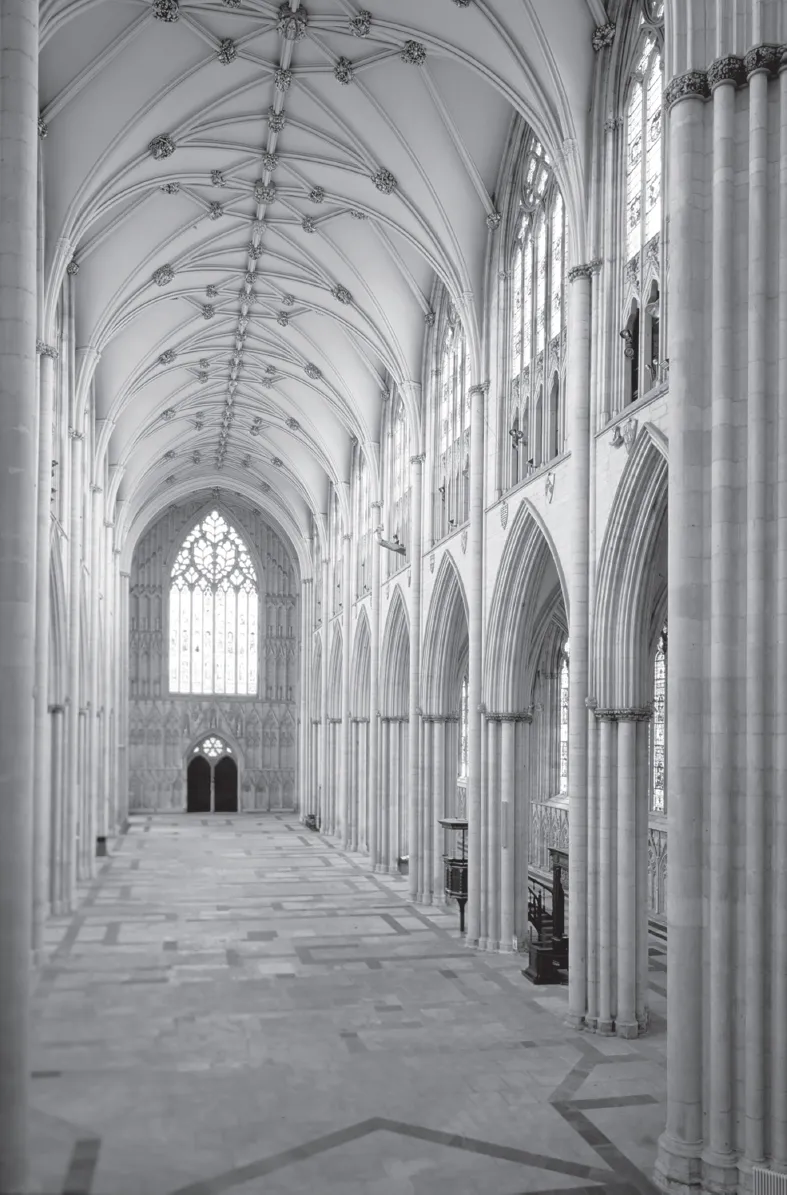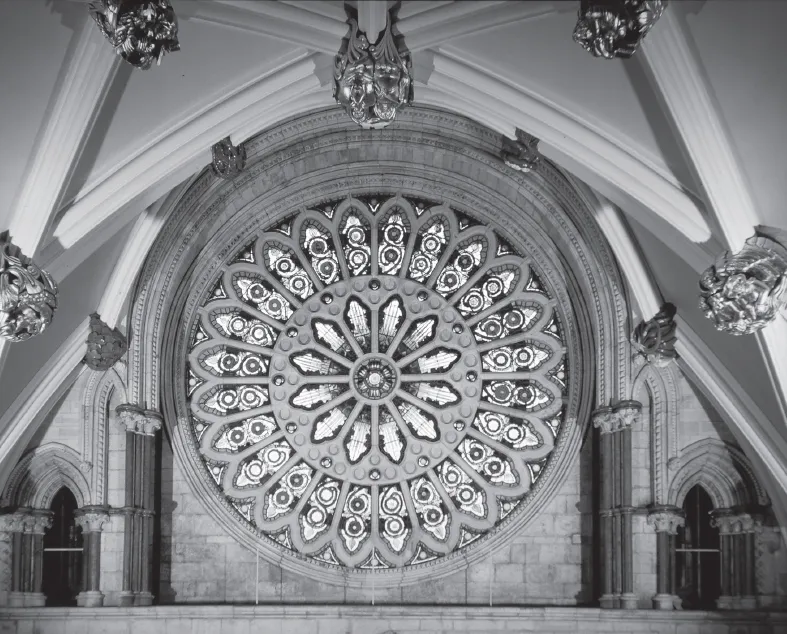![]()
Chapter 1
York
Spiritual centre in the north of England: York Minster
York Minster. (© Chapter of York: reproduced by kind permission)
York Minster is one of the biggest Medieval Gothic cathedrals in northern Europe and holds half of all the Medieval stained-glass in England. As the Mother Church of the Northern Province, it’s one of Britain’s most important spiritual centres and the seat not only of a bishop but an archbishop. It costs £20,000 a day to run and employs a full-time staff of 200, including thirty permanent glaziers and stonemasons, as well as 500 volunteers.
Its history stretches back to the Roman Emperor Constantine, who founded the first church in York in the 4th century. The first minster was a wooden church built in 627 for the baptism of King Edwin of Northumbria. Although the current minster is an impressive 800 years old, dating back to the 13th century when the 250-year building programme began, this is in fact the fourth minster to be built in the city – three others predate it.
What’s the difference between a cathedral and a minster?
Traditionally a minster is the Anglo-Saxon name for a missionary church and a minster was a church that had its own clergy or a church attached to a monastery. The word is associated with the Latin monasterium or monastery. Today it’s an honorific title given to particular churches in England. A cathedral is the seat of a bishop and the word is derived from the chair he sits on – the ‘cathedra’ – which makes York Minster both a minster and a cathedral. And its full name reflects this, ‘The Cathedral and Metropolitical Church of St Peter in York’.
Emperor Constantius I died in 306 AD and his son Constantine was proclaimed emperor as he visited the Roman troops stationed in York. He built York’s first place of worship to celebrate the news. The remains of the basilica he created can still be seen today beneath the minster in the undercroft, a fascinating link to the building’s early history.
The first York Minster was built in Saxon times by King Edwin, inspired – or in fact, instructed – by a woman. Edwin wanted to marry Ethelburga of Kent. She would only agree to come to York if she could continue her Christian worship. And along with Bishop Paulinus, one of the pope’s missionaries, she ended up converting Edwin to Christianity too. Built for his baptism in 627, the first church was a small wooden structure that was eventually rebuilt in stone.
Due to King Edwin’s efforts and Paulinus’ success in bringing Christianity to the people, York became an important religious and spiritual centre. In 735, when Pope Gregory III appointed Egbert as the first Archbishop of York, York Minster became the most important church in northern England, a status it retains to this day.
Edwin’s stone church burned down in 741 and was replaced just in time for the Viking invasion – the first recorded attacks took place in 866. But it appears that the Vikings respected York’s symbolic importance and, in 895, King Guthfrith, a Christian Viking, was buried in the minster.
The building was in a sorry state by the time William the Conqueror invaded England in 1066. He installed Thomas of Bayeux as Archbishop of York and in 1080 started to construct a new building in the Romanesque, or Norman, style. Not only was it the biggest church, it was also the biggest building in the north of England and dominated the landscape for miles around.
It was, in fact, a very pointed message from Thomas to his rival Lanfranc, the Archbishop of Canterbury. Lanfranc had already claimed primacy for Canterbury over York. By building a minster to rival the size of Canterbury Cathedral, Thomas was in effect thumbing his nose at the opposition. Work was completed on his ‘message’ around 1100.
But this still isn’t the church we see today. York Minster is one of the finest examples of Gothic architecture in England and the newstyle building gradually replaced the older Romanesque design over a period of more than 200 years. The first phase of rebuilding started around 1215 under Archbishop Walter de Gray and continued under twenty more archbishops, finally completing in 1472. Small ‘shadows’ still exist, however. We know that the former Norman cathedral was the width of today’s nave pillars, for example.
The nave was one of the earliest parts of the cathedral to be developed, between 1291 and 1350, in the ornately decorated Gothic style, with pointed rather than rounded arches allowing it to take greater weights and achieve soaring heights. It’s the widest Gothic nave in England and also one of the longest.
The history of the West Window
The majestic West Window sits over the great west doors, the ceremonial entrance to the minster leading to the mighty nave. Eight of York’s archbishops range along the bottom of the glass, including Archbishop Melton, who commissioned it in 1338. Above are the twelve apostles, though fitting all twelve into the eight horizontal panes means that some of them have had to double-up. Next come four pairs of panels depicting the life of Christ and the Blessed Virgin, from Annunciation to Nativity, Resurrection and Ascension. Above it all is a scene set in heaven, showing Mary crowned as queen sitting beside Christ. The beautiful heart shape of the stone tracery at the top gives the window the name it’s locally known by, ‘the heart of Yorkshire’.
But be aware that you’re looking at a mix of the 1330s and the 1980s when you gaze at this historic relic. The stonework of the frame had to be completely replaced in 1989 due to the effects of pollution and erosion, and the external carved arches of the doorway below were replaced in 1998.
Curious facts: the headless saints
Between the window and the doorway, the headless ‘semaphore’ saints raise their flags. If you know your semaphore history, you’ll realise that ‘flag semaphores’ – a system of sending messages by holding flags in certain positions according to an alphabetic code – were not widely used until the 19th century. A long time after the 1300s.
In fact, the saints are only ten years old. They were put on temporary exhibition in the cathedral and proved so popular with visitors that the church authorities bought them. But what are they signalling with their flags and why are they headless? Their flags spell out the phrase ‘Christ is here’. Their headless status we’ll come to later.
Don’t miss: body parts in the bosses
There are aspects of both mystery and humour in the nave. Although it dates from the Medieval period, the roof with its bosses doesn’t. It was destroyed by fire in 1840 and the current ceiling and all of its decorations are Victorian. The Victorians faithfully copied the designs of the Medieval bosses – all except one. Seven are exact replicas of representation of scenes from the life of Christ. The eighth, representing the Nativity, shows Mary feeding the baby Jesus from a bottle, Victorian sensibilities being too delicate to show her breastfeeding as she had been in the Medieval design. Look out also for Christ’s ascension into heaven – a very literal representation, accurately represented by the soles of his feet!
The famous dragon’s head is located halfway up the nave on the north side. It’s a solid oak carving, but its purpose remains a mystery. There’s a chain through the dragon’s neck. What was it used for? There’s a lot of speculation but the most commonly accepted theory is that it’s the remains of a very elaborate lifting mechanism. Maybe it was used to raise the 50-foot-high cover on the Medieval font that was lost during the time of the Reformation.
That’s not all that was lost in the Reformation. The aforementioned heads came a cropper also. Around the church you’ll see them, fullbodied representations of saints and religious icons, cut off at the neck. The ‘semaphore’ angels over the door are headless in sympathy with them, though they were created 500 years later.
The Reformation was not the only scourge faced by York Minster. It has also been plagued by fire, and three major fires have caused severe damage throughout its history.
The Nave. (© Chapter of York: reproduced by kind permission)
The quire, traditionally where services are sung and where the Archbishop of York has his cathedra, has a surprisingly modern feel. Instead of Medieval misericords, York Minster quire has fixed seats. The woodwork seems fresher, less faded. This is because all of the original woodwork, the roof and some of the stonework of the quire were destroyed by fire in 1829.
It was started by Jonathan Martin who had written several warning letters to the minster clergy complaining about how the church was being run. As his letters were ignored he decided to take matters into his own hands and stayed behind one night after evensong to set the blaze. The quire was completely destroyed. He was found guilty but not of sound mind and was sent to the Criminal Lunatic Department of Bethlem Hospital where he died nine years later.
The tower burned down in 1840 when a workman making repairs accidentally left a candle burning. The tower was timber, as was the roof of the nave, which was also destroyed. You can still see evidence of the 19th-century flames around the nave’s stone pillars, where several are coloured pink.
Curious facts: the illusion of the windows
Today’s tower is the same size as its Norman predecessor and you can have some fun with perspective here. Ask anybody to judge which windows are bigger – the windows high above in the tower or the Five Sisters Window in the north transept. To the eye, the Five Sisters Window looks the taller of the two. But it’s an optical illusion, created by the angle of the tower. They are in fact all the same size.
The south transept features the famous Rose Window. Its stonework dates from 1240 and the glass from the early 1500s, representing the Lancaster and Tudor roses. The window marked the union of the Houses of York and Lancaster under Henry VII. It is also sometimes known as the Marigold Window, due to the shape of its tracery.
Rose Window. (© Chapter of York: reproduced by kind permission)
Which brings us to the third fire, a much more recent occurrence in 1984, when a lightning storm hit the roof of the south transept, causing it to erupt in flames. Firemen trained water on it to make it cave-in and to prevent the flames spreading to the rest of the building. Afterwards there were 40,000 cracks in the Rose Window and it’s estimated if the heat of the fire had been two degrees higher, the lead holding it together would have melted and it would have been destroyed. Today the window is sandwiched between two panes of clear glass for protection.
Don’t miss: the ‘Blue Peter’ bosses
But out of the ashes rose the phoenix. After the devastation of the south transept, work began to rebuild the roof and all of its bosses. Iconic children’s TV show Blue Peter got involved and children all over the UK were invited to design bosses for inclusion in the new ceiling. Out of 34,000 entries, six were selected to be featured and provide interesting cultural references to what was uppermost in the mind of a child at that time.
Here you’ll see the man on the moon and Neil Armstrong, famine relief and save the whale. While the words ‘raising the Mary Rose’ might not ring many bells today, in the early 1980s it was a topic much discussed as a team of divers, archaeologists and scientists recovered the Tudor warship from the sea bed off the Isle of Wight. The excavation recovered thousands of artefacts from the time of King Henry VIII, ironically the man who was responsible for so much of the demolition of York Minster. The winning entry features a white and red rose surrounded by flames, a symbol of the beauty that grew out of destruction.
The south transept is the oldest part of the building and its construction began in 1220, largely the work of Archbishop de Gray. An enormously wealthy man, rumour has it that he paid £10,000 of his own money to the pope and Catholic clergy of the time to secure his position. Luckily he had enough money left over to start work on the cathedral building.
Opposite the Rose Window in the north transept, the Five Sisters Window is more austere in its tall grandeur and very much darker. It dates from a similar time, built in the mid-1200s, but why so different? A number of reasons in fact. The window is filled with grisaille glass. The word grisaille comes from the French for ‘greyness’. Don’t forget that while the structure of the Rose Window was created in the early 1200s, the colourful glass dates from the 16th century. And because the glass is older in the Five Sisters, it’s had to have a lot more repairs. Back in the day, that meant using lead to fill in cracks, blocking the light even further.
But there is something very contemporary about this window and that is its geometric patterning, reminiscent of Islamic design. It is said the window was commissioned by five unmarried sisters who were keen embroiderers and enjoyed working on patterns. Charles Dickens’ Nicholas Nickleby features the legend of how the Five Sisters Window was created.
Five Sisters Window. (© Chapter of York: reproduced by kind permission)
Don’t miss: the Chapt...




